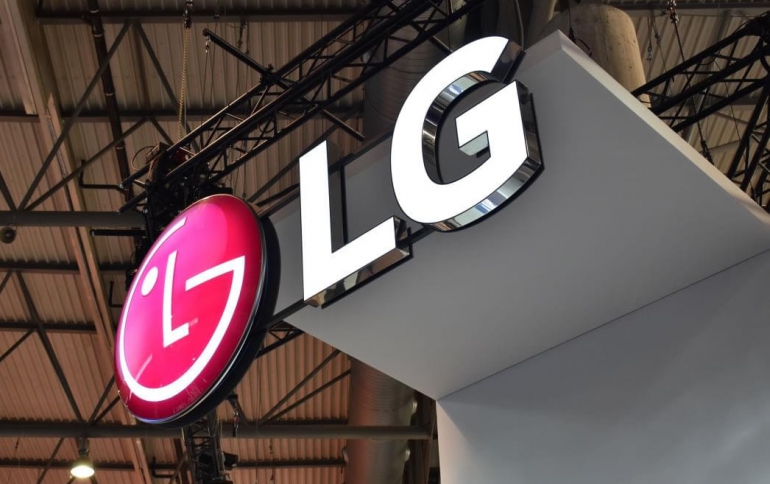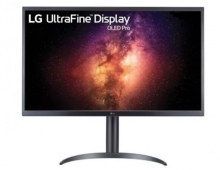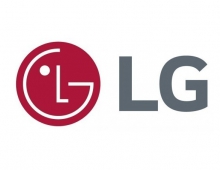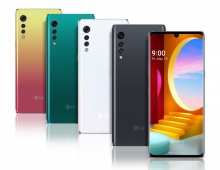
LG Demos Wireless Ultra HD Transmission, New Optimus Smartphones At MWC
LG Electronics is showcasing its Wireless Ultra High Definition (Ultra HD) Transmission technology for the first time at Mobile World Congress (MWC) 2013 in Barcelona. In addition, the company has on display four Optimus series devices - G, Vu:, F and LII and annnounced the acquisition of HP's WebOS.
LG's wireless streaming technology enables users to view games and other smartphone content on Ultra HD TVs in real time, via wireless data transfer.
"Thanks to our innovative Wireless Ultra HD Transmission technology, users can now enjoy their favorite mobile content on today's most advanced Ultra HD TVs," said Dr. Jong-seok Park, President and CEO of the LG Electronics Mobile Communications Company. "With the development of this cutting-edge technology, LG again confirms its industry leadership in the area of display and mobile convergence for a truly enjoyable viewing experience."
LG claims that its wireless Ultra HD Transmission technology makes the delivery of smartphone multimedia content to TVs faster and smoother than previous mobile video compression and transfer systems. With minimal lag and data loss, LG's next generation mobile feature performs this feat using ubiquitous WiFi connections. During transmission, multimedia content is automatically adjusted to match the receiving TV's screen resolution.

In addition, LG's Wireless Ultra HD Transmission system consumes less than half the power of other similar transmission technologies, according to LG. It achieves this by reducing the burden on the smartphone's CPU and other hardware resources, the company says.
LG also annoucned that HP's mobile operating system webOS will live on smart TVs and not in smartphones. LG has entered into an agreement with HP to acquire the source code, associated documentation, engineering talent and related websites associated with webOS. As part of the transaction, LG also will receive licenses under HP?s intellectual property (IP) for use with its webOS products, including patents acquired from Palm covering fundamental operating system and user interface technologies now in use across the industry.
With the transaction, LG will add the Sunnyvale and San Francisco sites to its global R&D locations, in addition to its existing U.S. sites in San Jose and Chicago.
Also under the agreement, LG will assume stewardship of the open source projects of Open WebOS and Enyo. HP will retain ownership of all of Palm?s cloud computing assets, including source code, talent, infrastructure and contracts. In addition, HP will continue to support Palm users.
Financial terms of the deal were not disclosed.
LG's presence at the MWC is also highlighted by the company's new smartphone lineup, which includes four Optimus series devices - G, Vu:, F and LII - all feature LG's next generation core technologies.
With an initial target to sell 10 million smartphone each quarter and double sales of LTE devices in 2013, this is LG's most ambitious smartphone strategy to date. Flagship models from the G and Vu: series will target the premium segment while the F and L series will be positioned as more mass audience smartphones for 4G LTE and the 3G markets, respectively.
 The Optimus G is the first smartphone to employ Qualcomm's Snapdragon S4 Pro Quad-Core processor. It features LG's True HD IPS Plus display and Zerogap Touch technology and also incorporates user-friendly UX features, such as QSlide, QuickMemo and Live Zooming.
The Optimus G is the first smartphone to employ Qualcomm's Snapdragon S4 Pro Quad-Core processor. It features LG's True HD IPS Plus display and Zerogap Touch technology and also incorporates user-friendly UX features, such as QSlide, QuickMemo and Live Zooming.
Originally launched in key target LTE markets, the LG Optimus G is making its debut in over 50 countries. The newest addition to LG's Optimus G series, the Optimus G Pro, was recently introduced to the Korean public. The Optimus G Pro is a 4G LTE-equipped smartphone with a 5.5-inch Full HD IPS display and new UX features such as Dual Recording and Virtual Reality (VR) Panorama.
A new hybrid LTE device that combines the portability of a smartphone with the viewing experience of a tablet, LG's Optimus Vu: is equipped with a 5-inch, 4:3 aspect ratio display. With the recent addition of the Optimus Vu: 2 in the Korean market, there are now two devices in Vu: Series that deliver UX features such as Vu: Talk and QRemote.
LG's Optimus F Series are 4G LTE smartphones for just about everyone. Both the Optimus F5 and Optimus F7 were specifically designed for consumers making the transition from 3G to 4G LTE networks. LG hopes that the launch of Optimus F Series this year will enable LG to expand its footprint in the burgeoning 4G LTE market.
The Optimus LII Series were developed around four new design elements: Seamless Layout, Laser Cut Contour, Radiant Rear Design and a home button with Smart LED Lighting.
First unveiled on LG's Optimus G, QSlide provides the ability to display two full-sized windows simultaneously. The recently upgraded version of QSlide allows for the opening of two apps at the same time in full screen mode and change the size, position and transparency of QSlide windows as needed. Video, browser, memo, calendar and calculator functions are all compatible with LG's multitasking UX. Dual Recording and Virtual Reality (VR) Panorama are two of the newest additions to LG's UX specifically designed to take advantage of the latest Full HD display technologies.
"Thanks to our innovative Wireless Ultra HD Transmission technology, users can now enjoy their favorite mobile content on today's most advanced Ultra HD TVs," said Dr. Jong-seok Park, President and CEO of the LG Electronics Mobile Communications Company. "With the development of this cutting-edge technology, LG again confirms its industry leadership in the area of display and mobile convergence for a truly enjoyable viewing experience."
LG claims that its wireless Ultra HD Transmission technology makes the delivery of smartphone multimedia content to TVs faster and smoother than previous mobile video compression and transfer systems. With minimal lag and data loss, LG's next generation mobile feature performs this feat using ubiquitous WiFi connections. During transmission, multimedia content is automatically adjusted to match the receiving TV's screen resolution.

In addition, LG's Wireless Ultra HD Transmission system consumes less than half the power of other similar transmission technologies, according to LG. It achieves this by reducing the burden on the smartphone's CPU and other hardware resources, the company says.
LG also annoucned that HP's mobile operating system webOS will live on smart TVs and not in smartphones. LG has entered into an agreement with HP to acquire the source code, associated documentation, engineering talent and related websites associated with webOS. As part of the transaction, LG also will receive licenses under HP?s intellectual property (IP) for use with its webOS products, including patents acquired from Palm covering fundamental operating system and user interface technologies now in use across the industry.
With the transaction, LG will add the Sunnyvale and San Francisco sites to its global R&D locations, in addition to its existing U.S. sites in San Jose and Chicago.
Also under the agreement, LG will assume stewardship of the open source projects of Open WebOS and Enyo. HP will retain ownership of all of Palm?s cloud computing assets, including source code, talent, infrastructure and contracts. In addition, HP will continue to support Palm users.
Financial terms of the deal were not disclosed.
LG's presence at the MWC is also highlighted by the company's new smartphone lineup, which includes four Optimus series devices - G, Vu:, F and LII - all feature LG's next generation core technologies.
With an initial target to sell 10 million smartphone each quarter and double sales of LTE devices in 2013, this is LG's most ambitious smartphone strategy to date. Flagship models from the G and Vu: series will target the premium segment while the F and L series will be positioned as more mass audience smartphones for 4G LTE and the 3G markets, respectively.
 The Optimus G is the first smartphone to employ Qualcomm's Snapdragon S4 Pro Quad-Core processor. It features LG's True HD IPS Plus display and Zerogap Touch technology and also incorporates user-friendly UX features, such as QSlide, QuickMemo and Live Zooming.
The Optimus G is the first smartphone to employ Qualcomm's Snapdragon S4 Pro Quad-Core processor. It features LG's True HD IPS Plus display and Zerogap Touch technology and also incorporates user-friendly UX features, such as QSlide, QuickMemo and Live Zooming.
Originally launched in key target LTE markets, the LG Optimus G is making its debut in over 50 countries. The newest addition to LG's Optimus G series, the Optimus G Pro, was recently introduced to the Korean public. The Optimus G Pro is a 4G LTE-equipped smartphone with a 5.5-inch Full HD IPS display and new UX features such as Dual Recording and Virtual Reality (VR) Panorama.
A new hybrid LTE device that combines the portability of a smartphone with the viewing experience of a tablet, LG's Optimus Vu: is equipped with a 5-inch, 4:3 aspect ratio display. With the recent addition of the Optimus Vu: 2 in the Korean market, there are now two devices in Vu: Series that deliver UX features such as Vu: Talk and QRemote.
LG's Optimus F Series are 4G LTE smartphones for just about everyone. Both the Optimus F5 and Optimus F7 were specifically designed for consumers making the transition from 3G to 4G LTE networks. LG hopes that the launch of Optimus F Series this year will enable LG to expand its footprint in the burgeoning 4G LTE market.
The Optimus LII Series were developed around four new design elements: Seamless Layout, Laser Cut Contour, Radiant Rear Design and a home button with Smart LED Lighting.
First unveiled on LG's Optimus G, QSlide provides the ability to display two full-sized windows simultaneously. The recently upgraded version of QSlide allows for the opening of two apps at the same time in full screen mode and change the size, position and transparency of QSlide windows as needed. Video, browser, memo, calendar and calculator functions are all compatible with LG's multitasking UX. Dual Recording and Virtual Reality (VR) Panorama are two of the newest additions to LG's UX specifically designed to take advantage of the latest Full HD display technologies.





















